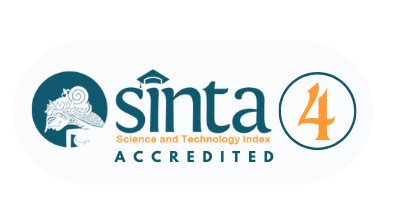Senior High School Second-Grade Language Students’ Perceptions on the Use of YouTube Videos
DOI:
https://doi.org/10.33633/es.v4i02.4578Abstract
Abstract. YouTube is a website that provides a lot of videos from all over the world. Then, YouTube also offers many benefits for the educational area, such as for learning a language. This study aimed to discover a private Senior High School second-grade students’ perceptions of using YouTube videos in language learning. The participants of this study consisted of ten second graders of language programs in that Senior High School. The data in this study were gathered by distributing open-ended questionnaires and doing some semi-structured interviews. This study found that YouTube has been very familiar to the students because most students watched YouTube every day for almost five hours. However, students faced some challenges and difficulties while learning the language through YouTube videos. Hopefully, this study can be useful for teachers and students to use YouTube effectively to learn languages.Keywords: YouTube; perceptions; language-program students; language learning.Abstrak. YouTube adalah sebuah situs internet yang menyediakan banyak video dari seluruh dunia. Situs ini menawarkan banyak manfaat dalam bidang pendidikan termasuk pembelajaran bahasa. Penelitian ini bertujuan untuk mengetahui persepsi siswa kelas dua sebuah SMA swasta tentang penggunaan video dari situs YouTube dalam pembelajaran bahasa. Responden penelitian ini terdiri dari sepuluh siswa kelas 2 dari sebuah program bahasa di SMA tersebut. Data diperoleh dari kuesioner “open-ended” dan juga wawancara “semi-structured”. Dari data, ditemukan bahwa YouTube sudah sangat dikenal dikalangan siswa karena sebagian besar siswa menonton vdeo YouTube setiap hari selama hampir lima jam. Namun demikian, ada juga beberapa tantangan dan kesulitan yang di hadapi siswa saat belajar bahasa melalui situs YouTube. Penelitian ini diharapkan bisa bermanfaat bagi guru maupun siswa dalam belajar bahasa melalui YouTube sebagai sarana belajar yang efektif.Kata kunci: YouTube, persepsi, mahasiswa program bahasa, pembelajaran bahasaReferences
Allan, M. (1985). Teaching English with video. Harlow: Longman
Almurashi, W. A. (2016). The effective use of YouTube videos for teaching English language in classrooms as supplementary material at Taibah University in Alula. International Journal of English Language and Linguistic Research, 4(3), 32-47. Retrieved from http://www.eajournals.org/wp-content/uploads/ The-Effective-Use-of-Youtube-Videos-for-Teaching-English-Language-in-Classrooms-as-Supplementary-Material-at-Taibah-University-in-Alula.pdf
Bull, S., & Ma, Y. (2001). Raising learners’ awareness of language learning strategies in situations of limited resources. Interactive Learning Environments, 9(2), 171-200. doi: https://doi.org/10.1076/ilee.9.2.171.7439
Burke, S. C., Snyder, S., & Rager, R. C. (2009). An assessment of faculty usage of YouTube as a teaching resource. The Internet Journal of Allied Health Sciences and Practice, 7(1), 1-8. Retrieved from http://kenanaonline.com/files/0060/60554/Burke.pdf
Creswell, J. W. (2014). Research design: Qualitative, quantitative, and mixed method approaches (4th edn). Los Angeles, London: Sage Publications. Retrieved from https://gul.gu.se/public/pp/public_file_archive/archive.html? publishedItemId=42564721&courseId=86421&fileId=42564716
Dawson, C. (2002). Practical research methods: A user-friendly guide to mastering research techniques and projects. Oxford, UK: How To Books. Retrieved from http://www.modares.ac.ir/uploads/Agr.Oth.Lib.21.pdf
Duffy, P. (2008). Engaging the YouTube Google-eyed generation: Strategies for using web 2.0 in teaching and learning. Electronic Journal E-Learning, 6(2), 119-130. Retrieved from http://www.ejel.org/issue/download.html?idArticle =64
Fleck, B. K. B., Beckman, L. M., Sterns, J. L., & Hussey, H. D. (2014). YouTube in the classroom: Helpful tips and student perceptions. The Journal of Effective Teaching, 14(3), 21-37. Retrieved from https://files.eric.ed.gov/fulltext/EJ1060489.pdf
Gorra, V. C., & Bhati, S. S. (2016). Student’s perception on use of technology in the classroom at higher education institutions in Philippines. Asian Journal of Education and E-Learning, 4(3), 92-103. doi: https://ro.uow.edu.au/buspapers/874
Jackson, R., Camara, S., & Drummond, D. K. (2016). What is qualitative research?. Qualitative Research Reports in Communication, 8(1), 21-28. doi: http://dx.doi.org/10.1080/17459430701617879
Kabooha, R., & Elyas, T. (2018). The effects of YouTube in multimedia instruction for vocabulary learning: Perceptions of EFL students and teachers. English Language Teaching, 11(2), 72-81. doi: https://doi.org/10.5539/elt.v11n2p72
Lonergan, J. (1984). Video in Language Teaching. New York, NY: Cambridge University
Muhammad, K. (2012). The use of YouTube in teaching English literature: The case of Al-Majma’ah Community College, Al-Majma’ah University (Case Study). International Journal of Linguistics, 4(4), 525-551. doi: https://doi.org/ 10.5296/ijl.v4i4.2930
Roodt, S., & Peier, D. (2013). Using YouTube in the classroom for the net generation of students. Issues in Informing Science and Information Technology, 10, 473-488. doi: https://doi.org/10.28945/1823
Syamlee, D. S., & Phil, M. (2012). Use of technology in English language teaching and learning: An analysis. 2012 International Conference on Language, Medias and Culture, 33, 150-156. Retrieved from https://pdfs.semanticscholar.org/8a64/8bf836bbed27c1a44195aa389d8b8841 cf50.pdf
Tamelan, K. O., & Listyani. (2018). Junior high school students’ perceptions on the use of YouTube videos for learning English. Proceeding of the 11th FLA International Conferences, 44-55.
Watkints, J., & Wilkints, M. (2011). Using YouTube in the EFL classroom. Language Education in Asia, 2(1), 113-119. doi: http://dx.doi.org/10.5746/LEiA/11/V2/I1/A09/Watkins_Wilkins






















